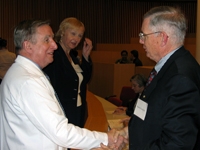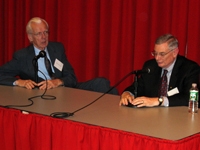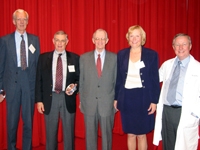
Dr. Antonio Gotto and Dr. Stephen Woods, professor of psychiatry at the University of Cincinnati, at the 2006 Irving Weinstein Symposium.
The feeling of craving food is well-known—that almost insatiable desire for chocolate or a soft drink that seems to come out of nowhere yet can only filled by a very specific food. But often these cravings are not satisfied by a simple taste; rather they require the entire chocolate bar or can of soda, and even then, we may have to tell ourselves, at least mentally, to stop.
A set of two lectures recently presented at the 5th Annual Irving Weinstein Visiting Lectureship in Nutrition and Disease Prevention in Weill Cornell Medical College's Weill Auditorium explored that need to keep eating, suggesting that not only are junk foods addictive in the same way as heroin and alcohol, but that the body may in fact turn off the normal signals that make us feel "full" when we are eating junk foods.
In the first lecture, titled "Sugar Addiction: Changes in the Brain and Behavior," Princeton Professor of Psychology Bart Hoebel applied the nuerochemical and behavioral criteria of drug addiction to sugar consumption in animals.
Hoebel created a model that taught rats to "binge" on a solution of sugar and water by escalating the first intake of the day and then depriving them for long periods, similar to the way a typical college student might binge drink after a week of studying or an addict might use heroin after a long withdrawal.
Hoebel found that the binging rats exhibited many of the hallmarks of addiction commonly associated with recreational drugs. Their brains, specifically the nucleus accumbens area, developed receptor sensitization; that is, the more they binged, the more their brains were ready to receive the addictive substance.
Perhaps more importantly, the rats strongly exhibited withdrawal behaviors like chattering teeth and reclusion as a result of their yo-yoing dopamine levels, a trait Hoebel called the "keystone of any drug addiction." The binging rodents also showed a strong relapse behavior when the sugar was removed and reintroduced, as well as "consummatory cross-sensitization," the gateway effect commonly associated with drugs like alcohol and cannabis.
Hoebel believes the findings may help redefine our understanding of eating disorders. "Drugs of abuse and feeding seem to act on the same system, yet the people who study eating disorders do not treat addiction," Hoebel said. "In genetically susceptible people, binging on sweet-fat food can lead to eating disorders like bulimia and anorexia."
The symposium's second lecture was delivered by Stephen Woods, professor of psychiatry at the University of Cincinnati and director of the university's Obesity Research Center. Woods' lecture, "Endocannabinoids: Novel Signals in the Regulation of Obesity," defined and described what he called "satiety signals," the chemical regulators that tell the brain, "I'm full, put down the fork."

Bart Hoebel and Dr. Stephen Woods discuss the metabolic component of junk-food addiction.
The body's signaling system consists of both adiposity signals like leptin and insulin that are continuously present in the circulatory system as well as signals from the endocannabinoid system that are synthesized as needed and destroyed when their job is complete. The arcuate nucleus—metabolism's central coordinator in the hypothalamus—integrates the complex of satiety signals to let the body know when it's time to stop eating. In this sense the endocannabinoid system acts as one mediator of obesity, it is one of several signals that can act as a "brake" on eating.
But sweet-fat foods may interfere with the endocannabinoid system's CB1 receptor, creating what Dr. Woods called a "disinhibition of food intake." And according to Dr. Woods, the driving force behind this interference may be flavor-based, not a need for more calories. Thus the brain doesn't tell the body to stop eating good-tasting foods, and those good-tasting foods are often high-fat, high-carbohydrate substances.

From left: Guest lecturers Bart Hoebel and Dr. Stephen Woods; Dr. Martin Lipkin, professor of medicine and president of the Irving Weinstein Foundation; Dr. Mary Charlson, the William T. Foley Distinguished Professor of Medicine; and Dr. Antonio Gotto.
"The endocannabinoid system is newly arrived on the block in terms of our understanding, but it has its fingers in a lot of metabolic functions," said Dr. Woods. "It has a particularly driving effect for foods based on taste, not necessarily caloric intake. There's a hedonic preference for taste and foods that taste good tend to be high in fat."
The Irving Weinstein Visiting Lectureship in Nutrition and Disease Prevention has been endowed since 1999 by the Irving Weinstein Foundation and has become a significant national forum on health and nutrition, and in particular disease prevention.
Photos courtesy of the Office of Development.
